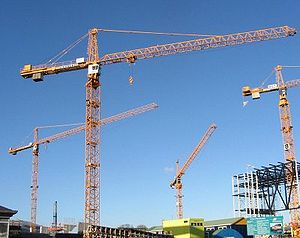安装塔式起重机 Installation of tower cranes from Allan Ha on Vimeo.
Tower cranes are a modern form of balance crane that consist of the same basic
parts. Fixed to the ground on a concrete slab (and sometimes attached to the
sides of structures), tower cranes often give the best combination of height and
lifting capacity and are used in the construction of tall buildings. The base is
then attached to the mast which gives the crane its height. Further, the mast is
attached to the slewing unit (gear and motor) that allows the crane to rotate.
On top of the slewing unit there are three main parts which are: the long
horizontal jib (working arm), shorter counter-jib, and the operator's cab.
Optimization of tower crane location in the construction sites has an important
effect on material transportation costs of a project.
Tower crane cabin
Tower crane with "luffing" jib The long horizontal jib is the part of the crane
that carries the load. The counter-jib carries a counterweight, usually of
concrete blocks, while the jib suspends the load to and from the center of the
crane. The crane operator either sits in a cab at the top of the tower or
controls the crane by radio remote control from the ground. In the first case
the operator's cab is most usually located at the top of the tower attached to
the turntable, but can be mounted on the jib, or partway down the tower. The
lifting hook is operated by the crane operator using electric motors to
manipulate wire rope cables through a system of sheaves. The hook is located on
the long horizontal arm to lift the load which also contains its motor.
A tower crane rotates on its axis before lowering the lifting hook. In order to
hook and unhook the loads, the operator usually works in conjunction with a
signaller (known as a "dogger", "rigger" or "swamper"). They are most often in
radio contact, and always use hand signals. The rigger or dogger directs the
schedule of lifts for the crane, and is responsible for the safety of the
rigging and loads.
Tower cranes can achieve a height under hook of over 100 metres.
Type of Tower Crane:
Static and mobile tower cranes are available in a wide variety of types and
configurations according to the particular combination of tower, jib and type
of base which they employ.
A Tower Crane, you can imagine, it can be divided into 3 parts.
thus, we will further discuss the different parts specific.
- JIB CONFIGURATION
- TOWER CONFIGURATION
- BASE CONFIGURATION
塔式起重機(英語:tower
crane),又稱塔式吊車,簡稱塔吊,是指機身為塔架式結構的全迴轉動臂架式起重機,為大型土木工程建築地盤內常見的運輸工具,建築材料、建築機械搬運,上高落低、縱橫交錯方向也可以,物件移動的任務能夠迅刻完成。通常約有10層樓高,呈「寸」字形,一端用來吊運物件,中間為控制室,另一端則以巨型混凝土塊確保平衡。由於結構有點像秤,所以在香港也俗稱為天秤(「秤」音「稱」)。塔式起重機通常會被固定在建築物中心,以便將物件搬到不同位置和高度。
一般天秤可分為固定式及流動式,而根據塔身,吊臂,及底架再細分不同種類。


留言
張貼留言